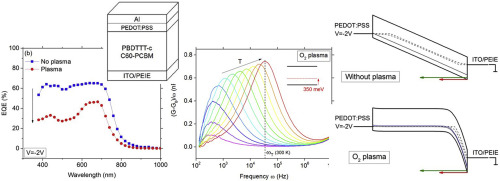Organic Electronics ( IF 3.2 ) Pub Date : 2017-12-12 , DOI: 10.1016/j.orgel.2017.12.008 Julie Euvrard , Amélie Revaux , Alexandra Cantarano , Stéphanie Jacob , Antoine Kahn , Dominique Vuillaume

|
Oxygen plasma is a widely used treatment to change the surface properties of organic layers. This treatment is particularly interesting to enable the deposition from solution of poly(3,4-ethylenedioxythiophene)-poly(styrenesulfonate) (PEDOT:PSS) on top of the active layer of organic solar cells or photodetectors. However, oxygen is known to be detrimental to organic devices, as the active layer is very sensitive to oxygen and photo-oxidation. In this study, we aim to determine the impact of oxygen plasma surface treatment on the performance of organic photodetectors (OPD). We show a significant reduction of the sensitivity as well as a change in the shape of the external quantum efficiency (EQE) of the device. Using hole density and conductivity measurements, we demonstrate the p-doping of the active layer induced by oxygen plasma. Admittance spectroscopy shows the formation of trap states approximately 350 meV above the highest occupied molecular orbital of the active organic semiconductor layer. Numerical simulations are carried out to understand the impact of p-doping and traps on the electrical characteristics and performance of the OPDs.
中文翻译:

意外氧气掺杂对有机光电探测器的影响
氧等离子体是一种广泛用于改变有机层表面性能的处理方法。为了使聚(3,4-乙撑二氧噻吩)-聚(苯乙烯磺酸盐)(PEDOT:PSS)的溶液能够沉积在有机太阳能电池或光电探测器的活性层上,这种处理特别有趣。然而,已知氧对有机器件有害,因为活性层对氧和光氧化非常敏感。在这项研究中,我们旨在确定氧等离子体表面处理对有机光电探测器(OPD)性能的影响。我们显示出灵敏度的显着降低以及器件外部量子效率(EQE)形状的变化。使用空穴密度和电导率测量,我们证明了氧等离子体诱导的活性层的p掺杂。导纳光谱法显示,在活性有机半导体层的最高占据分子轨道上方约350 meV处形成了陷阱态。进行了数值模拟,以了解p掺杂和陷阱对OPD的电气特性和性能的影响。



























 京公网安备 11010802027423号
京公网安备 11010802027423号